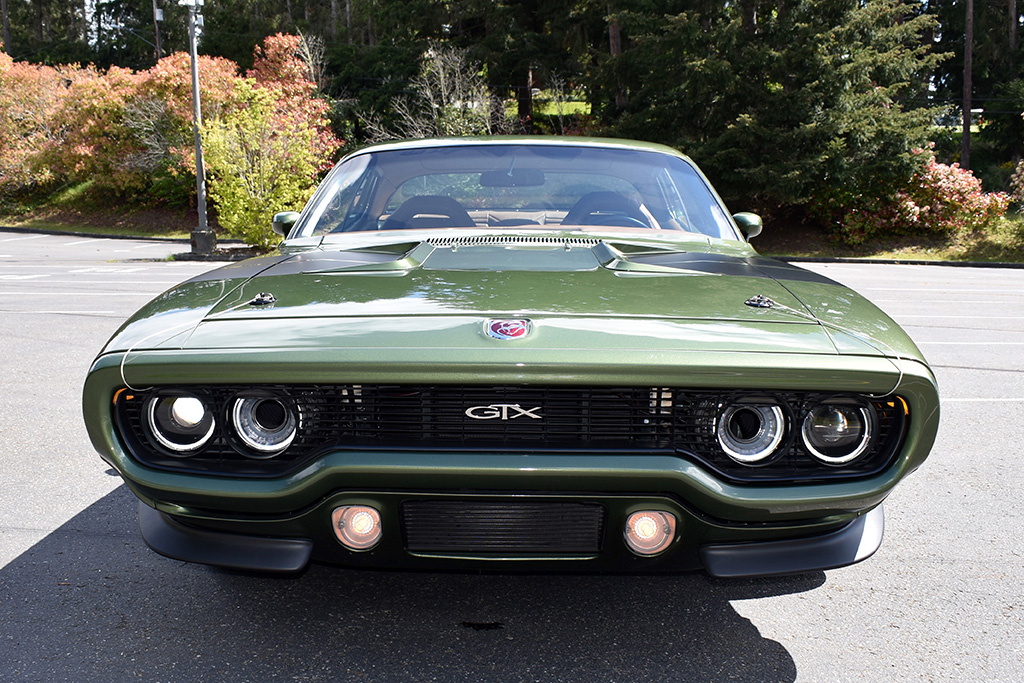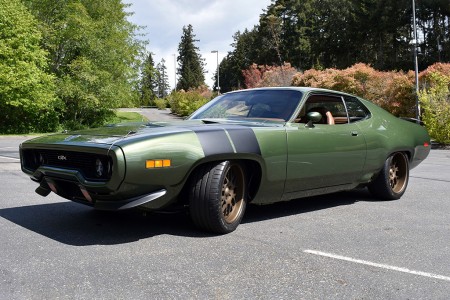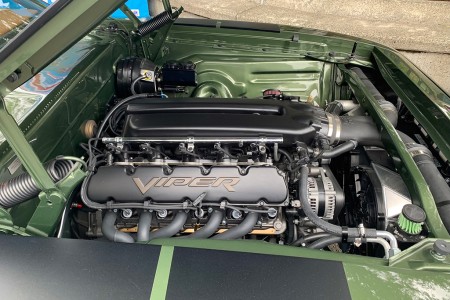Written by Nicole Ellan James

2022 HOUSTON AUCTION – 1971 PLYMOUTH GTX-R CUSTOM COUPE – NO RESERVE
Offered with No Reserve at the 2022 Houston Auction, October 20-22 at NRG Center, is a 1971 Plymouth GTX-R custom coupe that’s ready to strike. The Viper V10-powered car was built on a 1971 B-body platform, which is a model year that received significant styling changes.
 “B-body” or “B platform” was Chrysler’s midsize rear-wheel drive passenger car platform from 1962 through 1979. The platform endured significant changes throughout its production, but it is essential to note that all of Chrysler’s B-body cars shared the same chassis in a given model year, with only styling differences between the Dodge and Plymouth models. Otherwise the vehicles were mechanically identical.
“B-body” or “B platform” was Chrysler’s midsize rear-wheel drive passenger car platform from 1962 through 1979. The platform endured significant changes throughout its production, but it is essential to note that all of Chrysler’s B-body cars shared the same chassis in a given model year, with only styling differences between the Dodge and Plymouth models. Otherwise the vehicles were mechanically identical.
In 1967, the Plymouth GTX was introduced as the performance trim of the Plymouth Belvedere. The following year, Plymouth introduced the Roadrunner and the GTX positioned itself as its most luxurious trim option as well.
1971 was the final model year the GTX was produced as a stand-alone model. Since the GTX had the same body as the Roadrunner, both the cars looked the same but were branded differently. The redesign encompassed rounded “fuselage” styling — the fuselage being the middle section of an airplane designed to accommodate passengers or cargo. The car also received a raked windshield, hidden cowl and a loop-type front bumper around a deep inset grille and headlights.
In 1971, the Roadrunner underwent a significant design change, as did all other Chrysler coupes that year. The new design allowed the car to be much more aerodynamic, making the Viper V10 the perfect fit for the build due to its similar appearance to the new Roadrunner.
The GTX-R on the docket for Houston was built in a Pro-Touring style that can tackle the track or the street with ease, but also reflects the car’s history as an older muscle car. The car was built by its owner and consignor at his custom car shop in Bremerton, Washington.
The idea of building a custom GTX was considered, but most muscle car collectors know that a real GTX shouldn’t be modified because so few were produced.
The build began with a 1971 Roadrunner from the factory as a “plain Jane.” The car was born with a base 383ci engine with a standard transmission and factory color combination.
The custom couldn’t be called a GTX because the car wouldn’t be a clone or be another stock-looking car, so the addition of the “R” was decided on to give it a unique name.
A rendering was created of the vision for the car prior to the build. This rendering reportedly went viral and the car became internet famous before the restoration process even began.
 The goal of the build was to blend as much Viper into the car as possible without making major changes to the car’s look. As a result, the heart of the build is an 8.4-liter Viper V10 engine. It’s paired to a Viper Magnum T56 6-speed manual transmission with a Billet yolk and 4-inch aluminum driveline that sends power down to the custom aluminum 8.75 third member with a 3.70 Truetrac differential.
The goal of the build was to blend as much Viper into the car as possible without making major changes to the car’s look. As a result, the heart of the build is an 8.4-liter Viper V10 engine. It’s paired to a Viper Magnum T56 6-speed manual transmission with a Billet yolk and 4-inch aluminum driveline that sends power down to the custom aluminum 8.75 third member with a 3.70 Truetrac differential.
One of the most challenging parts of the build was getting the Viper V10 engine to look like it belongs in the engine bay since the car only came with a V8.
Despite the challenge, the result is rewarding. The car roars when it reaches over 4,000 RPM, reverberating when it is downshifted on the highway.
The third generation Viper V10 engine is a fresh build by Prefix, dyno tested with 630hp and 660 ft/lbs of torque.
The engine is cooled by a set of functioning Hellcat cold air intake headlights, a massive custom radiator with dual 10-inch SPAL fans powered by the engine control unit based on engine demand within a custom engine bay. Additionally, many components of the engine have Cerakote ceramic baked coating.
 The engine breathes through a Viper-inspired exhaust that exits on the side of the car, in a location where multiple pieces of the suspension come into play, along with the rear torque box. As a result, many of the components were re-engineered and thoughtfully hidden away during the build.
The engine breathes through a Viper-inspired exhaust that exits on the side of the car, in a location where multiple pieces of the suspension come into play, along with the rear torque box. As a result, many of the components were re-engineered and thoughtfully hidden away during the build.
Along with the fully welded chassis that has been stiffened and braced throughout, stopping power comes from 14-inch Baer 6-piston power disc brakes with a billet master cylinder.
The GTX-R has an eye-catching finish, with a modern F8 Green exterior paint color with a PG DBC base coat and House of Kolor primer and clear coat riding on a set of custom-made Satin Bronze Boze wheels, which are 18×8-inches in front and 19×11-inches in back.
The interior of the GTX-R draws inspiration from a Viper’s black and tan interior. The carpet is black, with Viper seats that have been bolstered and stitched to look like the 1971 GTX seat pattern. The center console is black while the rest of the interior, including the dash pad, is tan with the headliner composed of all one piece.
Other amenities include flushed front and rear glass, power windows, Restomod Air heat and air conditioning, and a set of Classic Instruments gauges that feature the GTX-R logo, horn button and a one-off dash plaque.
See this custom for yourself and hear its Viper engine roar as it crosses the block at the 2022 Houston Auction, October 20-22 at NRG Center.
